|
|

 Congress undercuts the South-Vietnamese government Congress undercuts the South-Vietnamese government The Arab-Israeli Yom Kippur or October War of 1973 The Arab-Israeli Yom Kippur or October War of 1973The textual material on this webpage is drawn directly from my work America – The Covenant Nation © 2021, Volume Two, pages 231-235. |

|
|
Also as part of this new democratic or anti-imperialism initiative, the Democrat-controlled Congress also began the move to take the running of American foreign policy away from the besieged President. In June of 1973, as the Senate Watergate hearing was running at full throttle, Congress passed the Case Church Amendment, announcing that at the end of a two-month period the President would no longer be permitted to provide any kind of direct military aid to South Vietnam. This undercut severely Nixon's use of the threat of a resumption of the bombing of North Vietnam in order to make that country observe the terms of the Paris Peace Accords. Not surprisingly, Congress's anti-imperialist measure had the rather predictable effect of encouraging North Vietnam (which was still getting large amounts of military aid from its Communist ally Russia) to resume its attacks on the South. In theory Congress's economic aid to the South would continue, even though the air attacks would cease. But a crisis in international oil prices (which more than quadrupled) in late 1973 left South Vietnam unable to pay for the fuel for its military. By the late spring of 1974 it had run out of funds. The Nixon White House (by that time under tremendous pressure because of the Watergate affair) petitioned Congress for supplemental funds to get South Vietnam through to the new fiscal year beginning only a month away at the end of June. But Congress responded with a resounding "no," and announced in addition that America would also be ending all further financial support of South Vietnam as of the end of 1976! All of this thoughtlessly sent a message to both friend and foe alike in Vietnam that the Saigon government was on its own, now that anti-imperialism and democracy were being restored in America. This greatly demoralized the pro-American Saigon regime in South Vietnam, and greatly emboldened the pro-Soviet Hanoi regime in the North.
|
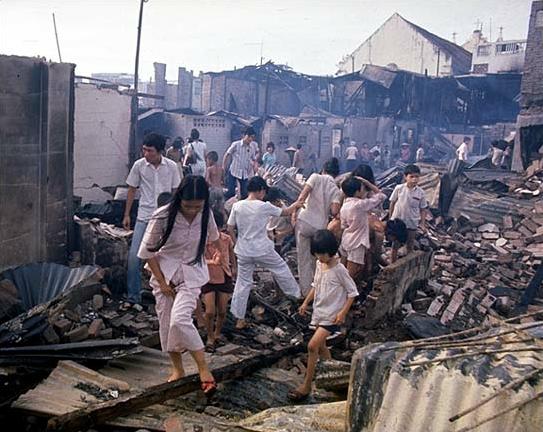
Vietnamese searching for
survivors of a North Vietnamese rocket attack on Saigon
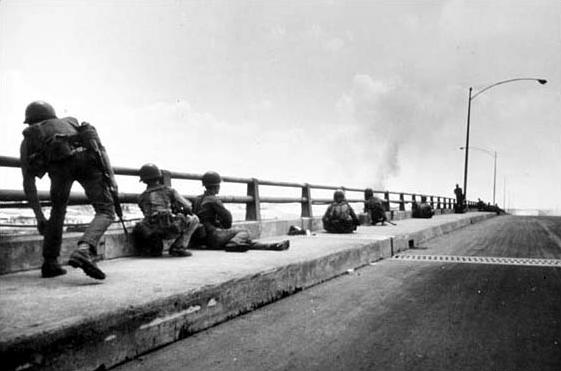
South Vietnamese troops' last stand before Saigon

|
|
The Arab-Israeli Yom Kippur or October War of 1973 and the subsequent global energy crisis What Saigon (and most of the rest of the world) was suffering from financially was the result of recent events arising, once again, from the on-going struggles between Israel and its Arab neighbors. Since the conclusion of the June 1967 War between Israel on the one hand and its Egyptian, Syrian and Jordanian neighbors on the other, no change in the status quo had occurred, despite the United Nations Security Council Resolution 242 calling for an Israeli withdrawal back to pre-war boundaries, and a mutual recognition of those boundaries by the Arab parties involved in the conflict. But Egypt, Syria and Jordan were still unwilling to recognize even the right of Israel to exist, much less willing to agree on any particular boundaries with Israel. And Israel was in no hurry to back down from its post-war position achieved against Egypt in the Sinai (all the way up to the Suez Canal), against Syria in the taking of its strategic Golan Heights, and against the Jordanians in the West Bank Region (the sole part of Palestine still theoretically Palestinian in character) which the Israelis now completely controlled. Year after year had gone by with no change in the status quo, Nasser had died in 1970, and Anwar as-Sadat had taken control of Egypt – quite anxious to get some movement on this issue in order to bring Egypt out of the economic and spiritual depression it had found itself caught in since the end of the 1967 war. Thus it was that he laid out a careful plan to break the stalemate both militarily and diplomatically (Sadat himself knew quite a bit about the game of Realpolitik!). With somewhat reluctant help from the Soviets (the Soviets seemed more interested in pursuing détente with the Americans than in getting mixed up with the Americans over another Mid-East blow-up), Sadat had modernized the Egyptian military considerably, and then in July of 1972 he expelled all Russian advisors (some 20,000 of them) from Egypt, producing confusion as to what Sadat was up to. Was he shifting away from the Soviets and towards the West? Indeed, he had been putting out political feelers with Western leaders about the prospects of getting something moving to break up the status quo. In the meantime, he was secretly working with Syrian President Assad concerning a joint action against Israel in order to recover lost Arab territories. And Assad was clearly expecting some kind of response from Arab oil exporters in support of any Israeli-Arab conflict that should break out. But most importantly, in the spring and summer of 1973 Sadat had been conducting a number of extensive military exercises, which had put the Israelis on major alert, only to have nothing in particular happen (thus quieting Israeli alarmists). But in October, Sadat's assembling yet another such military exercise was in fact no exercise at all. It was the real thing. Without warning, on October 6 (1973) Sadat's troops conducted an assault across the Suez Canal and then charged East into the Sinai Desert. It was the first day of the Jewish holiday of Yom Kippur, and also the beginning of the Islamic month of fasting, Ramadan. Although everyone was supposed to be distracted by holiday events, the Israelis were actually ready for the unexpected coming from Sadat. However, Israeli Prime Minister Golda Meir stressed that under no circumstances were the Israelis to strike first, lest they lose their last ally, America (the Europeans had distanced themselves from Israel out of fear of an Arab oil embargo against them if they got involved). But the Egyptian assault was bigger than the opposition the Israelis were prepared to offer. The Egyptians were much better prepared for an air war than had been the case in 1967, with Soviet Surface-to-Air Missiles (SAMs) taking a huge toll on the Israeli air force and canons and anti-tank missiles taking out huge numbers of Israeli tanks, and vice versa on both sides. Consequently, both Egypt and Israel found themselves conducting a bitter balance of air and ground power in the Sinai Desert. And quickly both sides were running out of planes, tanks and ammunition. By October 9th, the stalemated battle had become one simply of resupply, American planes and munitions being shipped to the Israelis and Soviet planes and munitions shipped to the Egyptians. Meanwhile the Syrians had attacked the Israeli position in the Golan Heights, though with only varying success against the Israelis. By the 10th the situation in the Golan Heights had swung in favor of the Israelis, and on the 11th Israel made the decision to invade Syria itself. Over the next few days most of the action in this war was focused on the battle for Syria. Iraq now sent troops to join Syria, and the Israeli drive toward Damascus ground down. This new Arab-Israeli conflict naturally brought the international community to action, supporting one side or the other, or trying to work out a cease-fire. The Soviets of course were supporting the Arabs (military resupplies arriving on the 9th), but Nixon and Kissinger ran into difficulties with their European allies, who refused to let America use their airspace to run supplies to Israel (only Portugal and the Netherlands would let American planes land to refuel on their way to Israel). By the 14th American supplies were beginning to reach Israel. The Arab oil cutback ... and the huge inflation in energy pricing Then the Arab world took action, particularly when on the 19th Nixon requested of Congress $2.2 billion in aid for Israel. That immediately prompted the Arab oil exporters to cut overall production by 5 percent – and place countries supporting Israel (like America, Portugal and the Netherlands) under a full oil embargo. With that, the Arab-Israeli conflict exploded itself into a full-scale international energy crisis. This in turn brought the matter before the United Nations Security Council which on the 22nd was able to negotiate a ceasefire proposed jointly by America and Russia. But Israel had momentum going, and pushed past the agreed-on ceasefire line, even crossing the Suez Canal to encircle the entire Egyptian 3rd Army, provoking a Soviet threat to intervene directly if Israel did not stop its advances. Consequently, by the 28th, the war had finally come to something of a standstill (but smaller actions and high tensions would last well into the beginning of 1974). Meanwhile the Arab oil producers continued to shrink production, deepening the energy crisis to the extent that the cost of oil went from $3 to $12 per barrel (with gasoline therefore experiencing a similar four-fold jump in price), and made the acquiring of such energy (for instance gasoline at the pump) difficult to come by even then. Nixon at first opened America's strategic oil reserves for production, but this had only a rather small impact on the crisis. He then had the speed limit on federal highways lowered to 55 miles an hour, to reduce consumption. Certainly for the Arab oil exporters (Egypt and Syria were not part of that privileged group), the wealth that came to the Arab world was spectacular. For instance, Saudi Arabia was very careful to see that this windfall profit would find its way to all its Saudi citizens, newly rich by any standards. Even some of the Persian Gulf states were able to claim that their people now enjoyed the highest per capita income level in the world. But for other countries, such as Iran, such sudden wealth actually produced more social problems than it solved. And Iran's Shah would ultimately (1979) find himself overthrown, in large part due to the economic disruption caused by the flooding of wealth into Iran – on a very unequal basis.
|
The Yom Kippur War– October 6 to 26, 1973
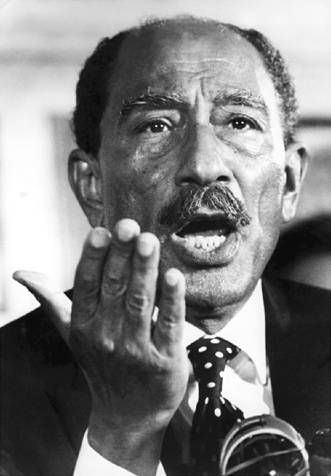
Egyptian President Anwar as-Sadat
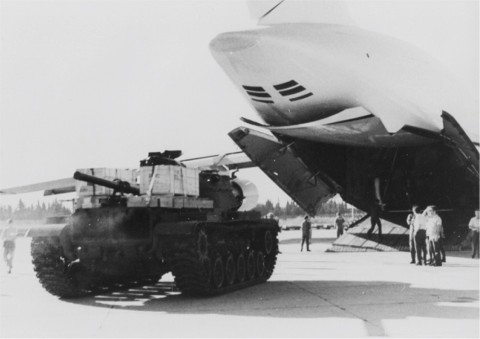
A C-5 Galaxy unloads an M-60
Patton tank at Ben Gurion International Airport
during Operation Nickel
Grass
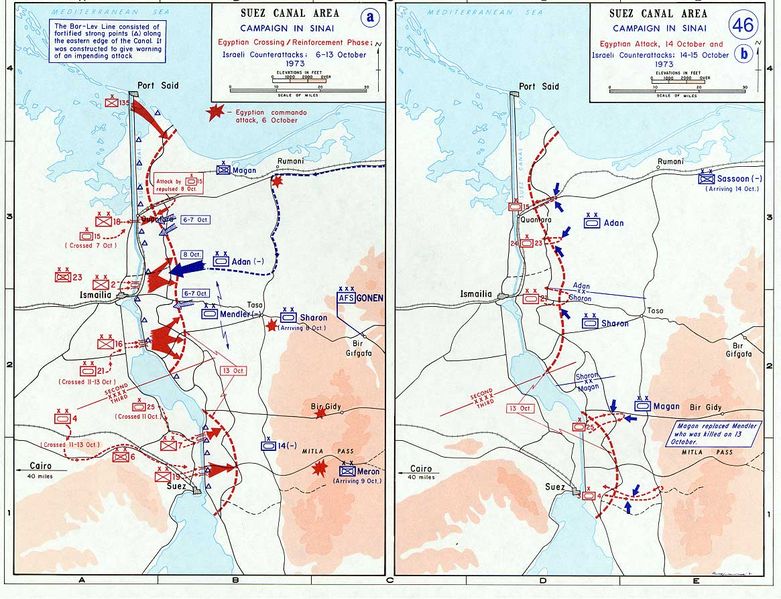
The 1973 War in the Sinai,
October 6-15
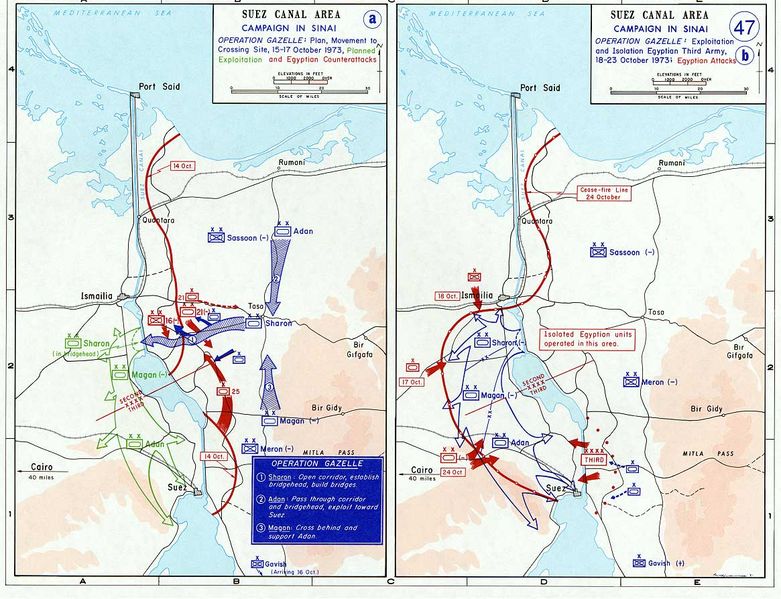
The 1973 War in the Sinai,
October 15-24
Yom Kippur War – October
1973
Israeli paratroopers breaking through an
Egyptian commando ambush
in a sandspit leading to Fort Budapest
on the Sinai front
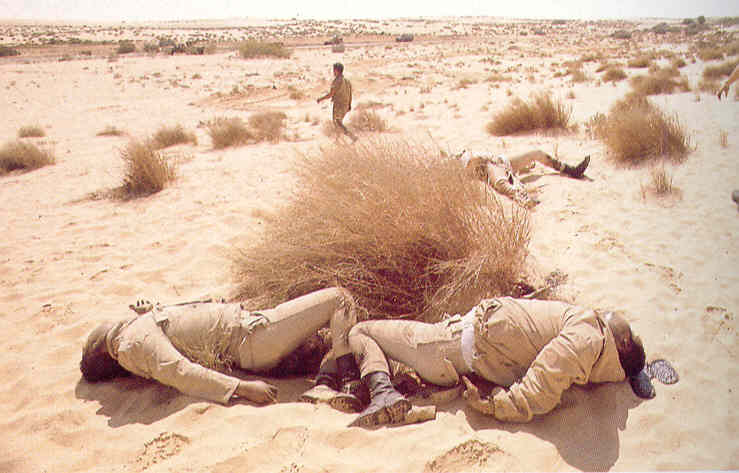
Egyptian soldiers killed
during the October or Yom Kippur War – 1973
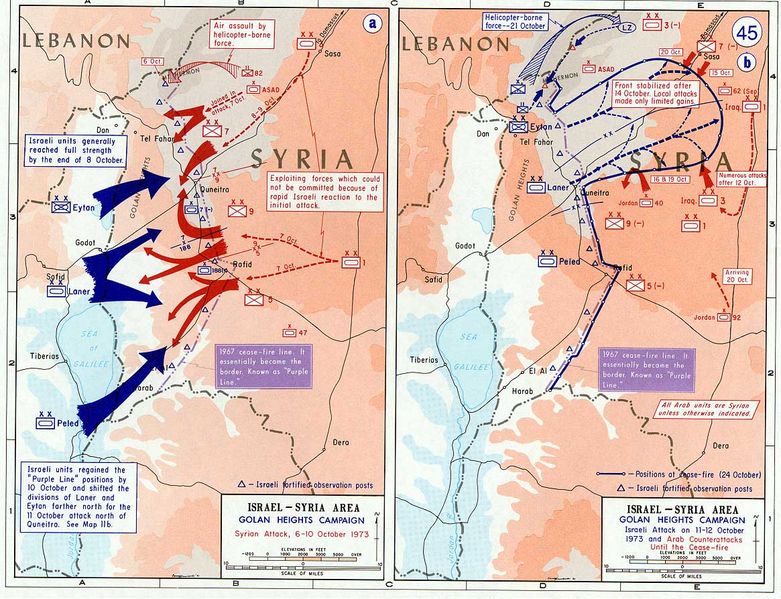
Yom Kippur War – Syrian
Theater
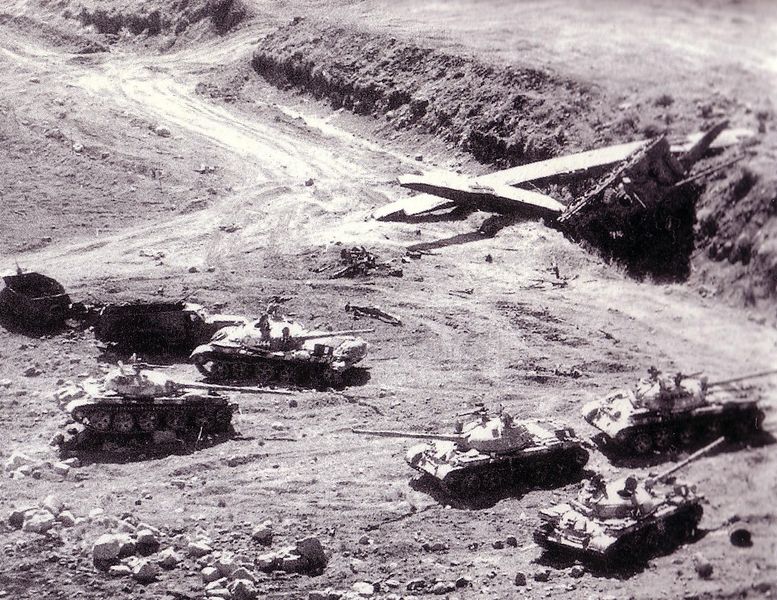
"Syrian tanks at Israeli
anti-tank ditch in the Golan. A tank, hit by Israeli fire, has fallen off
one
of the two bridges the Syrian laid across the ditch. Another knocked
out tank lies in the ditch.
To the left is the roadway the Syrians later
succeeded in opening through the barrier."
King Khalid overlooking a
model of a $8.5 billion military city,
to be paid for with increased oil
revenues – mid-1970s.
Gas shortage during the 1973
OPEC oil embargo imposed on the West for its support of Israel
in the October 1973
Arab-Israeli or 'Yom Kippur' War
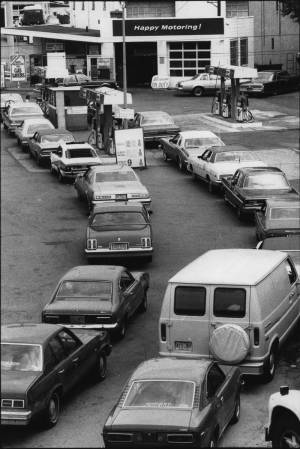
Gas lines
Gas shortage during the 1973 OPEC oil embargo imposed on the West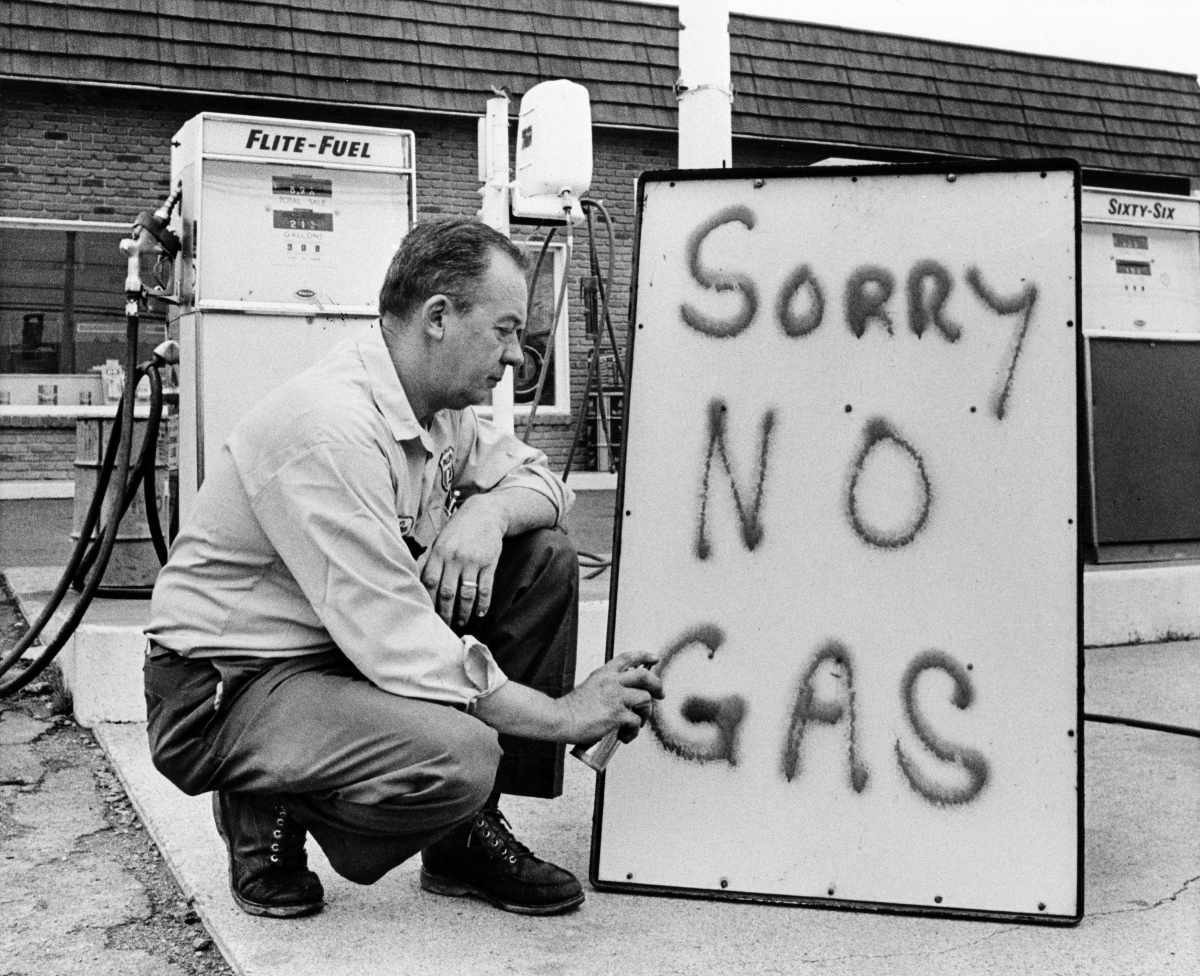


 Miles
H. Hodges
Miles
H. Hodges